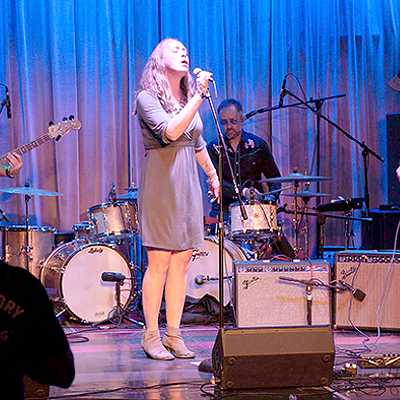"Oh, yes, that was me," Corbin groans, still abed at 10 a.m. in a hotel in the northern coastal town of Arcata, Calif. He's referring to the shower scene in the movie Dancemaker. When he's on tour with the Paul Taylor Dance Company, facing an afternoon of rehearsals and an evening of performance, he sleeps as late as he can. And as the Oscar-nominated film documented, the only way he can get going on tour mornings is to consign his aching dancer's body to the ministrations of a hot shower.
For the movie, a wonderful look not only at Taylor's choreographic method but at the working life of dancers, Corbin obligingly allowed the camera to record the hot water gradually limbering up his body, like an oil can put to a rusty machine.
"I wake up hurting when we're in the middle of a performance tour," says Corbin cheerfully, talking on the bedside phone. "But it's not grueling, not while you're in California. This is a very nice tour. We had two weeks in San Francisco, and here (in Arcata) it's beautiful, then L.A., and then the desert."
The troupe that some critics believe is the premiere modern dance company in the world alights in Tucson one night only, Saturday, April 14, at Centennial Hall.
Taylor's choreography, says Corbin, who's been with the company 11 years, "is the most joyous thing to come and watch. It's athletic, lyrical, all-encompassing. He's a very human choreographer. ... If you've been to see dance a million times or never, everyone leaves loving it."
A winner of almost every award the dance world has to offer, Taylor this year marks his 70th birthday, as well as a lifetime of dedication to modern dance. Taylor, whose troupe last stopped in Tucson in 1995, is an iconoclast who prides himself on being anti-ballet. In the '50s and early '60s he was a soloist with the legendary Martha Graham Dance Company, and when he struck out on his own as a choreographer he insisted on challenging dance convention. He became famous for such ploys as a "dance" that consisted of a single dancer standing motionless upon a soundless stage. (A critic responded by running a review with no words.)
The company has about 23 dances in its repertoire, Corbin notes, all of the pieces "all Paul Taylor all the time." The Tucson program, consisting of three long works, will be a typically varied Taylor concert, going from beauty to evil to sexuality, and offering a reworking of a popular dance form.
"Cascade," a 2-year-old work set to J.S. Bach, is "a study in symmetry, a group piece that's lyrical and lovely, pleasing to the eye," Corbin says.
The "Fiends Angelical," brand new this year, is "not what you'd call a pretty piece. It has a George Crumb score, and it's a tribal, ritualistic, gnarly bloodbath. It's dark but there is movement toward hope and light. It's very beautiful, angular and confrontational.
"We're all existing in a hellacious place, overseen by a priestess. (Another dancer) and I strangle each other to death. It's a ball to do."
"Piazzolla Caldera" is a 5-year-old dance. Like "Company B," a Taylor piece danced here last fall by Ballet Arizona, "Piazzolla" offers an inventive Tayloring of a popular dance form. "Company B" reworked World War II swing dance. This one does tango.
"He took the traditional tango and created his own vocabulary," Corbin says. "It's fantastic, a study in the age-old battle between the sexes. It's the most overtly sexual dance Paul has ever done; usually sexuality is understated in his work. But this is overtly sexual, women with men, men with men, women with women."
Dancemaker depicts the choreographer as difficult and demanding, but Corbin counters that his dancers get the benefit of "working with one of the creative geniuses in history. We've found a way to work well together."
Corbin, a native of Potomac, Md., who now lives in New York, studied tap and jazz as a child, and branched out into ballet as he grew older. He danced professionally with American Ballet Theatre II and then the Joffrey, where he first "was introduced to Paul's work. I fell in love with it." When he grew unhappy at the Joffrey, Corbin sought out Taylor, and ended up in a three-day audition with 300 other men.
"I didn't expect to get in the company, but he ended up taking me and five other guys."
Now a senior dancer with the company, Corbin says he relishes the Taylor method of creating new works. It's a collaboration of sorts with his dancers.
"He works from a visceral point of view, a personality point of view: He makes pieces on an individual. It's not so easy at first; you size each other up, but then it's great."
At 70, Taylor is still in superb physical condition, Corbin says, and producing new dances at a rapid rate. Where he usually choreographs about two new pieces a year, this year he's already made three, and it's only April.
"He's going to keep on going. There's no slowing him down," says Corbin.
And with that, Corbin himself speeds up. He excuses himself: He has things to do. He needs to drag his body from the bed and put it into the morning's shower, restoring his bones and muscles and limbs for a day of dance.
UApresents offers the Paul Taylor Dance Company in concert at Centennial Hall at 8 p.m. Saturday, April 14. UA dance prof John Wilson gives a free talk at 7:15 p.m. in Room 102 of the UA Center for English as a Second Language, just north of Centennial. Concert tickets are $30 to $42, with discounts offered to UA employees, students and children. Tickets are available at the box office at 621-3341. Non-discounted tickets are available at www.tickets.com.














